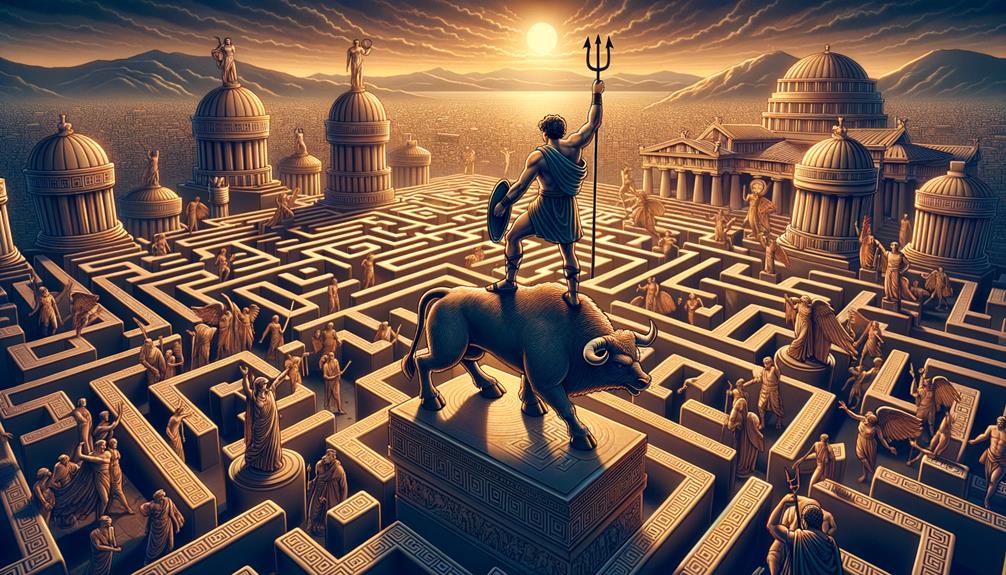Do you enjoy ancient Greek mythology? If so, let me share one of my favourite stories with you – the tale of Theseus and the Minotaur. This epic saga is a captivating battle of courage against savagery.
Picture Theseus, our brave hero, stepping into the labyrinth in Crete. This maze, a perfect symbol of life's complicated trials, was brilliantly designed by Daedalus, a top-tier architect of his time. Inside the labyrinth lurked the terrifying Minotaur, a monster that brings to life our darkest fears.
Despite the odds, Theseus fought and defeated the Minotaur. His victory was a powerful statement of overcoming hardships. Now, if you're interested in digging deeper into this intricate story, I assure you there's more to it than what appears at first glance. Prepare to uncover some amazing facts about this classic Greek myth.
The Myths Historical Background
Digging into the historical backdrop of the Theseus and the Minotaur myth, we can trace its foundations back to the Minoan civilization of ancient Greece. Here's a story that captures your attention. It's set on the island of Crete, where King Minos ruled. At the heart of the story is the courageous Athenian prince, Theseus, and his bold confrontation with the Minotaur in a maze.
Though the tale has been retold in various forms, its soul remains the same. It touches on universal themes of bravery, sacrifice, love, and the victory of good over evil. More than just a story, it's a mirror reflecting the cultural and mythical heritage of ancient Greece. It also offers deep insights into human nature. This myth embodies the spirit of a time and the imagination of a people.
Significant Characters Detailed
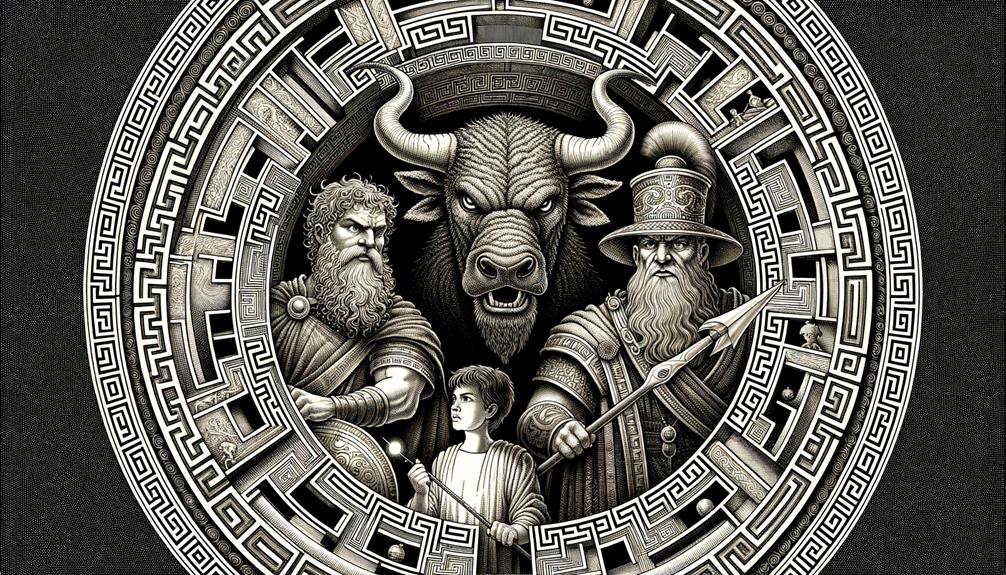
Why don't we take a moment to chat about the important characters in the 'Theseus and the Minotaur' myth? First up, we have the fearless hero, Theseus. Then, we'll discuss the terrifying creature known as the Minotaur. By doing so, we'll gain a better grasp of their roles and why they matter so much in this story. This will give us a deeper understanding and appreciation of this riveting myth.
Profiling Theseus: The Hero
Ever heard the story of the Minotaur? The real star of that tale is Theseus, the courageous prince from Athens, who decided to tackle the monster himself. Let's talk about the three things that made Theseus stand out in the story:
- First off, Theseus wasn't just a regular guy; he was the son of King Aegeus – a prince with his whole future at stake.
- Then there's his bravery. I mean, who willingly signs up to fight a Minotaur, a creature trapped in a maze? Theseus did, and that's pretty impressive.
- Finally, there's the love angle. Theseus and Princess Ariadne had a thing. She even helped him find his way through the labyrinth, adding a bit of romance and suspense to his story.
In the end, Theseus is the embodiment of a hero's journey. He's not just brave; he's also smart and capable of deep love. Quite the hero, right?
Unraveling the Minotaur Mystery
Let's dive into the gripping myth of Theseus and the Minotaur. It's a story packed with compelling characters, each adding their unique touch to the plot. First up, we have King Minos, the tough-as-nails ruler of Crete. He's got a monstrous pet named the Minotaur, a horrifying mix of man and bull, cooped up in a labyrinth. This isn't your average labyrinth, though. It's the brainchild of the genius architect Daedalus and it's designed to be a deadly trap for the sacrificial offerings from Athens, meant to satisfy the Minotaur's frightening appetite.
And then, there's Ariadne, King Minos's daughter who brings a touch of romance and intrigue to the tale. She gives Theseus, our hero, a mere thread. But this isn't just a thread, it's a lifeline in the twisty, turny maze. Her role highlights the tight-knit relationship of love, courage, and trickery in this captivating myth.
The Labyrinth and the Minotaur
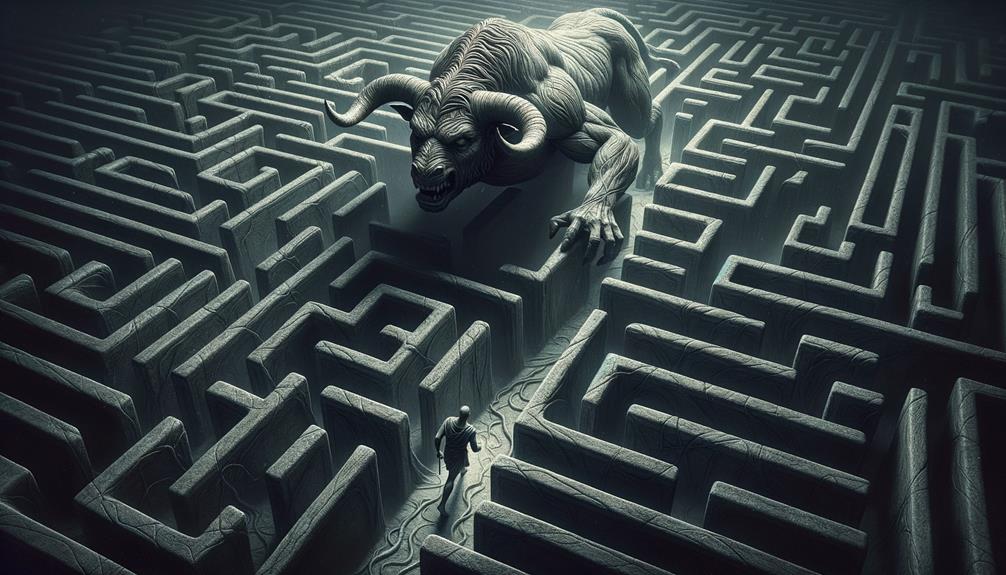
Diving into the tale of the Labyrinth and the Minotaur, let's first chat about where the Minotaur came from. Picture a creature birthed from Queen Pasiphae's unusual fondness for a bull. This beast is the perfect example of the terrifying consequences when nature's boundaries are crossed. Moving on, we'll take a look at the labyrinth, a maze with an impressively complex layout, designed to keep this monstrosity trapped. After that, we'll delve into the courageous adventure of Theseus as he navigates through the labyrinth's twisted corridors.
Origins of the Minotaur
Nestled in the core of a baffling maze in Knossos, Crete, the Minotaur is a terrifying beast with a bull's head and a man's body. It represents the tough obstacles life throws at us and our inherent desire to face and conquer them. The origin of this creature is woven into a complex fabric of myths and symbolism.
- King Aegeus made every effort to lift the curse that had befallen his kingdom, a curse that required the sacrifice of Athenian youngsters to the Minotaur in Crete every nine years.
- The story of Theseus and the Minotaur, on the other hand, provides a glimpse of optimism. Theseus, the son of the king, courageously offered himself to be the one to slay the Minotaur.
- The creature lived in a maze masterfully crafted by Daedalus, which serves as a metaphor for the intricate challenges we encounter in life.
The Labyrinths Intricate Design
As you delve into the complex design of the labyrinth, you can't help but appreciate the skill of Daedalus. This isn't just a maze; it's a work of art, meant to keep the terrifying Minotaur at bay, while reflecting the tough challenges we face in life. The labyrinth's design is more than just evidence of Daedalus' talent; it's a mirror of our daily struggles. Built with painstaking precision, it stands as a testament to Daedalus' brilliance and the terror of the Minotaur.
Consider this breakdown of the labyrinth's elements:
| Labyrinth's Element | What It Symbolizes | Who Implemented It |
|---|---|---|
| Complexity | The Challenges We Face in Life | Daedalus |
| Imprisonment | The Minotaur's Confinement | Daedalus |
| Location | The Ancient City of Knossos | Daedalus |
| Entrapment | Life's Trials and Tribulations | Daedalus |
| Design | The Brilliance of Daedalus | Daedalus |
Theseus Heroic Adventure
The labyrinth's complex layout reflects the sheer brilliance of Daedalus, but it's Theseus' journey within that truly highlights its symbolic importance. The mission Theseus undertook had three main objectives:
- Figure out the labyrinth's complicated layout
- Face and defeat the Minotaur
- Get out of the labyrinth using Ariadne's thread
The heroism of Theseus really stands out as he embarks on this dangerous mission, showing an unusual mix of bravery, smarts, and resolve. His victory over the Minotaur stands as a symbol of humanity's triumph over daunting challenges. The labyrinth helps us understand Theseus' trials and ultimate success, giving us a glimpse into the true nature of heroism. Hence, Theseus' journey through the labyrinth, fraught with peril and uncertainty but ending in triumph, embodies the very essence of heroism.
Theseus Victorious Return
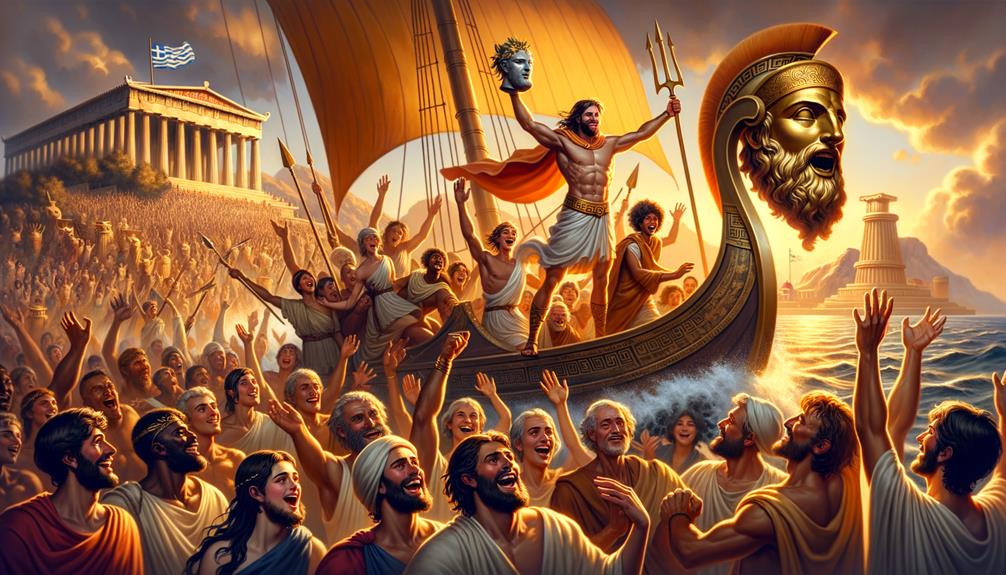
After defeating the Minotaur in the infamous labyrinth of Knossos, Theseus, with Ariadne's thread as his guide, freed the Athenian captives and began his journey back home, marking the beginning of his triumphant return to Athens.
As the ship of Theseus neared the shores of Athens, the black sails, which originally symbolized mourning, were switched out for white ones, a clear sign of his victory. Unfortunately, his father, King Aegeus, who had been waiting anxiously for his son's return, wasn't able to see this transformation.
| Theseus' Return | Significance of Color | Who Saw It? |
|---|---|---|
| Beginning | Black | King Aegeus |
| Triumph | White | Athenians |
| Misunderstanding | Black | King Aegeus |
| Celebration | White | Athenians |
This misunderstanding, though unfortunate, led to a tragic outcome for King Aegeus. But let's save that story for another time. For now, let's focus on the glorious victory of Theseus and his triumphant return from the Minotaur's labyrinth.
Symbolism in the Myth
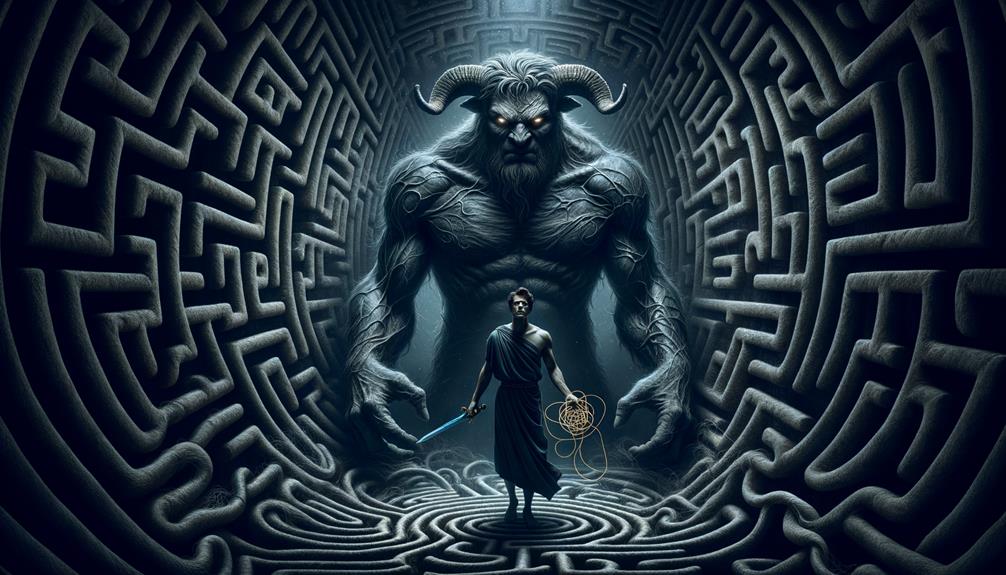
Let's take a break from the excitement of Theseus' victorious return and delve a bit deeper into the story. You see, the elements of this myth, like the labyrinth, the Minotaur, and Ariadne's thread, are much more than just exciting plot twists – they're loaded with meaning.
Just think about it:
- The labyrinth is a metaphor for the complex and sometimes confusing journey we call life. Each turn represents the challenges we all face, and the winding path is a reminder of our own personal struggles.
- The Minotaur, hiding in the labyrinth's shadows, is a symbol of our personal fears and insecurities. Just as Theseus had to confront this terrifying creature, we too must face our own inner demons to move forward.
- Ariadne's thread, given to Theseus, represents guidance and support. It's like a helping hand in times of difficulty, a lifeline we can hold onto when everything else seems uncertain.
Unveiling Hidden Trivia
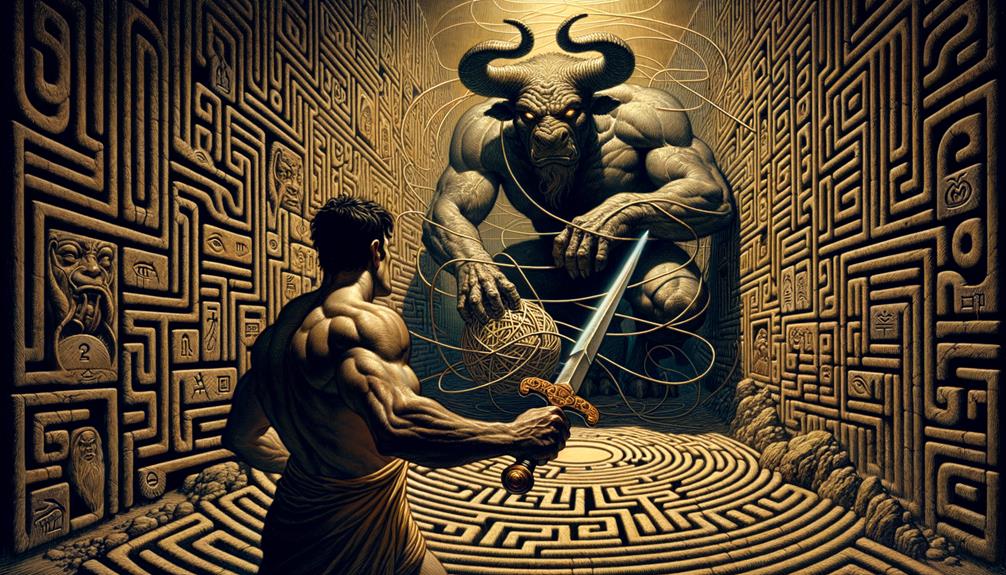
Let's have a chat about something really fascinating. You know the Greek myth of Theseus and the Minotaur, right? Well, back in 1990, a man named Robert Abbott produced a unique logic maze game based on that very tale, aptly called 'Theseus and the Minotaur'. In this game, you get to play as Theseus, navigating through a grid-based maze while being hot on the heels by the Minotaur. But here's the catch: the monster moves twice as fast as you. Clever, right?
This isn't just any maze, though. You have to be strategic about your movements. It's this unique twist that's made the game such a standout in the world of puzzles. So, if you think about it, Abbott has kind of given us the chance to experience the thrill of the original myth – outwitting the Minotaur and making your way out of the maze with every calculated move.
Frequently Asked Questions
What Is the Story of Theseus and Minotaur?
You're asking about a classic tale, right? It's the story of Theseus, a real hero who decided to take on a big challenge. He ventured into this crazy maze, faced off against a seriously scary creature called the Minotaur, and managed to win. But here's the cool part – he only found his way out thanks to Ariadne's thread. It's a pretty epic story about overcoming the odds.
Why Was Theseus Foolish to Defeat the Minotaur?
I think Theseus may not have been the wisest in his decision to take on the Minotaur. He overlooked some significant factors, like not heeding Ariadne's guidance and forgetting to switch his ship's sails. This mishap resulted in his father's unfortunate demise, showing that even though he conquered the Minotaur, he was still careless.
What Is the Conflict in Theseus and the Minotaur?
The tale of Theseus and the Minotaur is primarily concerned with the grim task of putting an end to the brutal practice of sacrificing young Athenians. Our protagonist, Theseus, steps up to the plate to tackle this issue. He fearlessly goes toe-to-toe with the Minotaur, putting an end to the gruesome ritual and, in the process, earning the title of a hero.

